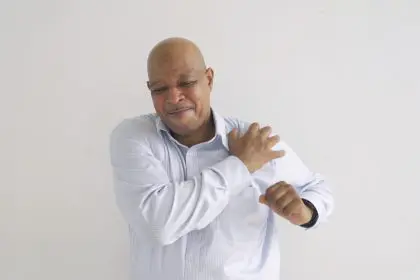That nagging ache in your shoulder has been bothering you for weeks now, and your lower back seems to protest every time you bend over to pick something up. Your wrists feel stiff in the morning, and climbing stairs leaves your knees feeling like they belong to someone decades older. These aren’t just signs of getting older or working too hard – they could be symptoms of musculoskeletal disorders that affect how your body moves and functions.
Musculoskeletal disorders represent one of the most common health problems affecting people worldwide, yet many dismiss their symptoms as normal wear and tear or temporary inconveniences. These conditions involve your bones, muscles, joints, tendons, ligaments, and other structures that work together to support your body and enable movement.
Understanding musculoskeletal disorders is crucial because they can significantly impact your quality of life, work performance, and ability to enjoy daily activities. What starts as minor discomfort can progress to chronic pain and disability if not properly addressed. The good news is that early recognition and appropriate treatment can often prevent progression and restore normal function.
The complexity of your musculoskeletal system means these disorders can manifest in countless ways, affecting different parts of your body and causing varying degrees of pain, stiffness, and functional limitation. Recognizing the patterns and understanding when symptoms warrant attention can make the difference between temporary discomfort and long-term disability.
Understanding your body’s movement system
Your musculoskeletal system functions like an intricate machine with hundreds of moving parts that must work in perfect coordination. Bones provide the structural framework, muscles generate the power for movement, joints allow flexibility and range of motion, while tendons and ligaments connect everything together and provide stability.
This system handles enormous stresses throughout your daily life, from the simple act of walking to more demanding activities like lifting, carrying, and athletic pursuits. Every movement requires precise coordination between multiple muscles, joints, and supporting structures, all working together seamlessly when everything functions properly.
When any component of this system becomes damaged, inflamed, or dysfunctional, it can create a cascade of problems that affect movement patterns and cause pain. A problem in one area often leads to compensatory changes in other areas, potentially creating additional issues over time.
The remarkable thing about your musculoskeletal system is its ability to adapt and heal, but this same adaptability can sometimes work against you when poor movement patterns or chronic stress lead to persistent problems that become increasingly difficult to resolve.
Common types of musculoskeletal disorders
Arthritis and joint degeneration
Arthritis represents one of the most widespread musculoskeletal disorders, affecting millions of people with varying degrees of joint pain, stiffness, and reduced mobility. The condition involves inflammation and breakdown of cartilage within joints, leading to bone-on-bone contact that creates pain and limits movement.
Osteoarthritis develops gradually as joint cartilage wears down over time, often affecting weight-bearing joints like knees, hips, and spine. The condition typically begins with minor stiffness and occasional pain that worsens with activity and improves with rest. As it progresses, pain may become constant and significantly limit daily activities.
Rheumatoid arthritis involves your immune system attacking joint tissues, creating widespread inflammation that can affect multiple joints simultaneously. Unlike osteoarthritis, this condition often causes morning stiffness that lasts for hours and may be accompanied by fatigue, fever, and other systemic symptoms.
Joint degeneration can also occur following injuries, infections, or due to genetic factors that affect cartilage quality. Regardless of the underlying cause, joint problems tend to worsen over time without appropriate treatment and lifestyle modifications.
Back and spine disorders
Lower back pain affects nearly everyone at some point, but chronic back disorders can become debilitating conditions that interfere with virtually every aspect of daily life. The complex structure of your spine, with its vertebrae, discs, muscles, and ligaments, creates multiple opportunities for problems to develop.
Disc problems occur when the cushioning structures between your vertebrae become damaged, herniated, or degenerated. This can create pressure on spinal nerves, causing pain that radiates into your legs or arms, along with numbness, tingling, or weakness in affected areas.
Muscle strain and spasms in your back can result from sudden movements, poor posture, or chronic stress on spinal structures. These problems often create a cycle where pain leads to muscle tension, which increases pain and reduces mobility, making recovery more difficult.
Spinal stenosis involves narrowing of the spaces within your spine, potentially compressing nerves and causing pain, numbness, or weakness that may worsen with walking or standing for extended periods.
Repetitive strain injuries
Modern work and lifestyle patterns have made repetitive strain injuries increasingly common, affecting people who perform the same motions repeatedly over extended periods. These conditions develop gradually as tissues become overused and inflamed from constant stress without adequate recovery time.
Carpal tunnel syndrome affects your wrists and hands, causing numbness, tingling, and pain that often worsens at night or during activities requiring repetitive hand movements. The condition results from pressure on the median nerve as it passes through the narrow carpal tunnel in your wrist.
Tennis elbow and golfer’s elbow involve inflammation of tendons around your elbow joint, causing pain that may radiate down your forearm. Despite their names, these conditions commonly affect people who don’t play sports but perform repetitive arm and wrist movements in their work or daily activities.
Shoulder impingement occurs when tendons in your shoulder become pinched between bones during arm movements, causing pain and reduced range of motion that often worsens with overhead activities.
Muscle and soft tissue disorders
Fibromyalgia creates widespread muscle pain and tenderness throughout your body, often accompanied by fatigue, sleep problems, and cognitive difficulties. The condition involves changes in how your nervous system processes pain signals, making normal sensations feel painful.
Myofascial pain syndrome involves trigger points in muscles that create localized areas of pain and stiffness. These tight knots in muscle tissue can cause referred pain in other areas and may limit range of motion in affected muscles.
Tendinitis occurs when tendons become inflamed from overuse or injury, causing pain and stiffness that typically worsen with movement. Common locations include the Achilles tendon, rotator cuff, and tendons around the knee.
Recognizing the warning signs
Pain patterns that shouldn’t be ignored
Musculoskeletal disorders often begin with subtle symptoms that gradually worsen over time. Persistent pain that lasts more than a few days without clear improvement should be taken seriously, particularly if it interferes with your normal activities or sleep patterns.
Pain that occurs with specific movements or positions may indicate mechanical problems with joints, muscles, or other structures. This type of pain often provides clues about which structures are involved and can guide treatment approaches.
Morning stiffness that lasts more than 30 minutes may suggest inflammatory conditions like rheumatoid arthritis, while stiffness that improves with movement but worsens after periods of inactivity might indicate osteoarthritis or other degenerative conditions.
Pain that radiates from one area to another, such as back pain that travels down your leg or neck pain that extends into your arm, often indicates nerve involvement and requires prompt evaluation to prevent permanent damage.
Functional limitations that impact daily life
Reduced range of motion in joints can be an early sign of developing problems, even before significant pain occurs. Difficulty reaching overhead, bending to tie shoes, or turning your head to look over your shoulder may indicate joint stiffness that could worsen without intervention.
Weakness in specific muscle groups often accompanies musculoskeletal disorders and can create compensatory movement patterns that lead to additional problems. Difficulty climbing stairs, lifting objects, or maintaining balance may indicate muscle weakness that needs to be addressed.
Changes in your walking pattern or posture often develop as your body tries to compensate for pain or stiffness in certain areas. These adaptations can create stress on other parts of your musculoskeletal system and contribute to additional problems over time.
Systemic symptoms that accompany local problems
Fatigue that seems disproportionate to your activity level may accompany inflammatory musculoskeletal conditions. This fatigue often feels different from normal tiredness and may not improve with rest.
Sleep disturbances frequently occur with musculoskeletal disorders, as pain and stiffness interfere with comfortable sleep positions and restorative rest. Poor sleep, in turn, can worsen pain and delay healing processes.
Mood changes, including depression and anxiety, commonly develop in people dealing with chronic musculoskeletal pain. These psychological symptoms can become significant problems in their own right and may interfere with treatment and recovery.
Risk factors and causes
Occupational and lifestyle factors
Certain occupations create higher risks for developing musculoskeletal disorders due to repetitive motions, heavy lifting, prolonged sitting or standing, or exposure to vibration. Office workers, construction workers, healthcare providers, and factory workers all face specific risks related to their job demands.
Poor posture during work or daily activities creates chronic stress on your musculoskeletal system, potentially leading to pain and dysfunction over time. Forward head posture, rounded shoulders, and slouched sitting positions are particularly problematic in our technology-driven society.
Sedentary lifestyles contribute to muscle weakness, joint stiffness, and poor movement patterns that can predispose you to musculoskeletal problems. Lack of regular physical activity also reduces bone density and muscle mass, making injuries more likely when demands are placed on these structures.
Age-related changes
Natural aging processes affect all components of your musculoskeletal system, including decreased bone density, reduced muscle mass and strength, changes in cartilage composition, and decreased flexibility in ligaments and tendons.
Hormonal changes, particularly the decrease in estrogen that occurs with menopause, can accelerate bone loss and increase the risk of osteoporosis and fractures. These changes also affect joint health and may contribute to the development of arthritis.
Previous injuries or trauma to your musculoskeletal system can create lasting effects that increase your risk of developing problems later in life. Even seemingly minor injuries that healed well may create subtle changes that become problematic over time.
Treatment approaches that work
Conservative management strategies
Most musculoskeletal disorders respond well to conservative treatment approaches when implemented early and consistently. Rest and activity modification allow inflamed tissues to heal while preventing further damage from continued stress.
Physical therapy plays a crucial role in treating musculoskeletal disorders by addressing movement patterns, strengthening weak muscles, improving flexibility, and teaching proper body mechanics. A skilled therapist can identify specific problems and develop targeted treatment plans.
Pain management through various methods, including heat and cold therapy, massage, and appropriate medications, can provide relief while other treatments address underlying problems. The goal is to control pain enough to allow participation in rehabilitation activities.
Exercise therapy, when properly prescribed and supervised, can address many of the underlying factors that contribute to musculoskeletal disorders. Strengthening exercises, flexibility training, and cardiovascular conditioning all play important roles in comprehensive treatment plans.
Advanced treatment options
Injections of corticosteroids or other medications directly into affected joints or soft tissues can provide targeted relief for inflammation and pain when conservative treatments aren’t sufficient. These procedures can often provide months of improvement and allow participation in rehabilitation programs.
Surgical interventions may become necessary when conservative treatments fail to provide adequate relief or when structural problems require correction. Modern surgical techniques often allow for minimally invasive procedures with faster recovery times.
Alternative treatments, including acupuncture, chiropractic care, and massage therapy, may provide additional benefits when used as part of comprehensive treatment plans. These approaches can be particularly helpful for managing chronic pain and improving quality of life.
Prevention strategies for long-term health
Workplace modifications
Ergonomic improvements in your work environment can significantly reduce the risk of developing occupational musculoskeletal disorders. This includes proper chair height, monitor positioning, keyboard placement, and tools designed to reduce repetitive stress.
Regular breaks from repetitive activities allow tissues to recover and prevent the accumulation of stress that leads to injury. Simple stretching exercises during breaks can help maintain flexibility and reduce muscle tension.
Proper lifting techniques and the use of mechanical aids when handling heavy objects can prevent acute injuries and reduce cumulative stress on your spine and other structures.
Lifestyle modifications for prevention
Regular exercise that includes cardiovascular conditioning, strength training, and flexibility work helps maintain the health of all components of your musculoskeletal system. Exercise also helps maintain healthy body weight, which reduces stress on weight-bearing joints.
Proper nutrition supports bone health, muscle function, and tissue repair processes. Adequate calcium and vitamin D intake are particularly important for bone health, while protein intake supports muscle maintenance and repair.
Stress management is important because chronic stress can increase muscle tension, interfere with sleep, and contribute to inflammation throughout your body. Techniques like meditation, yoga, or regular relaxation can help manage stress levels.
Living well with musculoskeletal health awareness
Early intervention makes a difference
Recognizing early warning signs and seeking appropriate treatment before problems become severe can often prevent the development of chronic, disabling conditions. Many musculoskeletal disorders are much easier to treat in their early stages.
Building healthy movement habits and maintaining good posture throughout your daily activities can prevent many common musculoskeletal problems from developing in the first place.
Maintaining function and quality of life
Even when musculoskeletal disorders develop, appropriate treatment and lifestyle modifications can often restore normal function and prevent progression to more serious problems. The key is working with healthcare providers to develop comprehensive treatment plans that address your specific needs and goals.
Staying active within your limitations helps maintain function and prevents the deconditioning that can worsen musculoskeletal problems. Adapted exercise programs can often allow continued participation in enjoyable activities despite some limitations.
Understanding your condition and taking an active role in your treatment gives you the best chance of maintaining independence and quality of life. This includes following prescribed treatments, making recommended lifestyle changes, and communicating openly with your healthcare team about your symptoms and concerns.
Your musculoskeletal system serves you throughout your entire life, and taking care of it should be a priority at every age. Whether you’re dealing with current problems or working to prevent future issues, understanding these conditions and their treatment options empowers you to make informed decisions about your health and well-being.

















